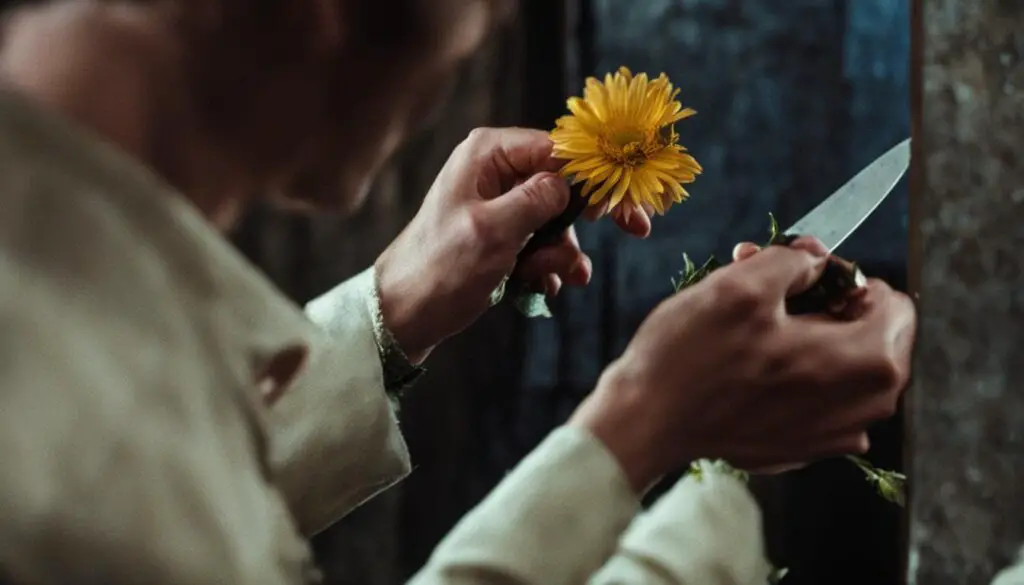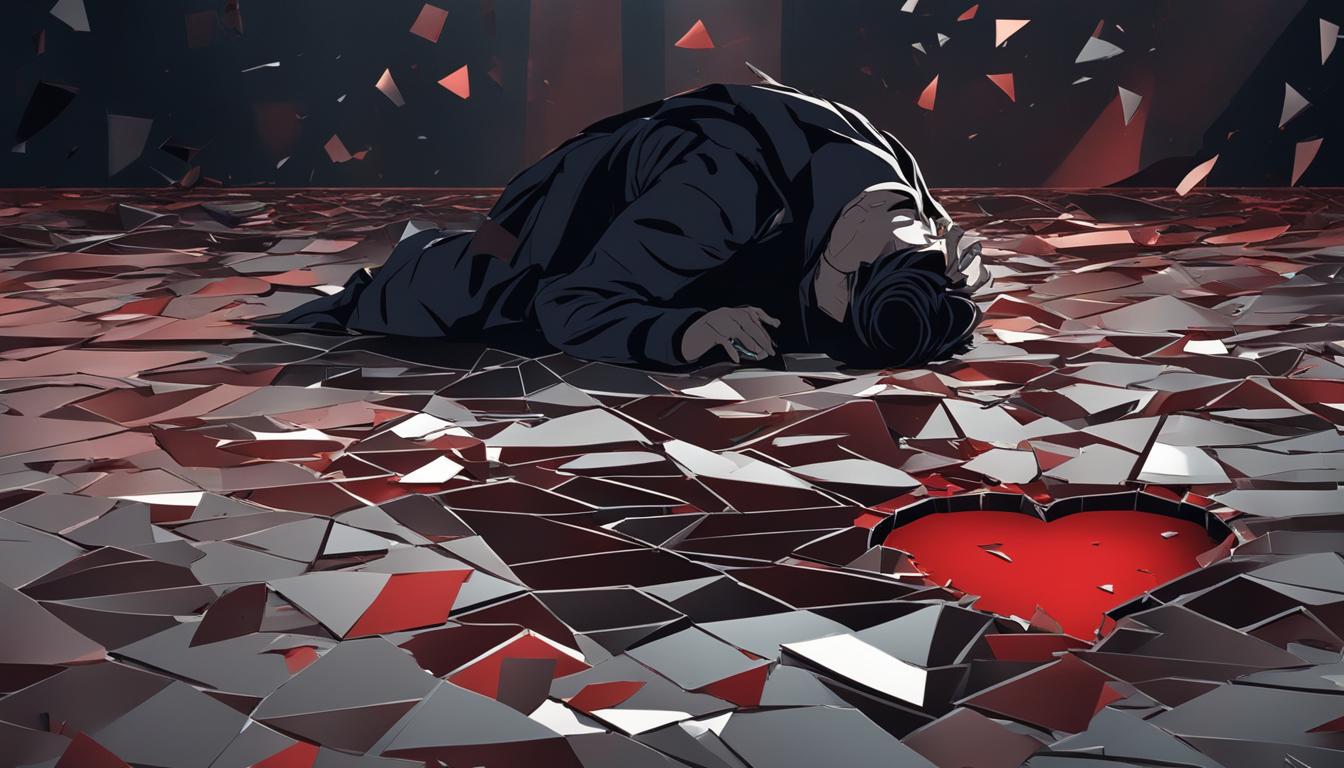Betrayal, a theme that resonates deeply with human emotions, finds its expressive power through symbolism in literature and art. The symbolic representation of betrayal captures the profound impact of broken trust on our psyche. Visual cues such as broken chains, shattered glass, and torn hearts are evocative symbols employed to convey the pain and trauma of betrayal. These symbols serve as poignant metaphors for the feelings of hurt, disappointment, and loss that arise from being betrayed.
Literary works and artistic representations often delve into the theme of betrayal through the use of specific characters or events. The figures of Julius Caesar, Amir in “The Kite Runner,” and the biblical story of Samson and Delilah showcase the complexities of betrayal and its consequences. These narratives explore the depths of human emotion and offer a rich exploration of the symbolism associated with this universal human experience.
Key Takeaways:
- Symbolism in literature and art captures the intense emotions of betrayal.
- Broken chains, shattered glass, and torn hearts symbolize the pain and trauma of broken trust.
- Characters like Julius Caesar, Amir, and events such as Samson and Delilah represent betrayal in literary works.
- Betrayal touched by symbolism offers a deeper understanding of the human experience.
- Exploring the symbolism of betrayal provides solace and a means of navigating pain and healing.
Symbols of Betrayal in Different Cultures
Betrayal symbolism extends beyond literature and art, permeating various cultures and traditions. In Greek mythology, the Trojan Horse is a powerful symbol of deceit and betrayal, representing the cunning and treachery of the Greeks. Christianity uses Judas Iscariot’s betrayal of Jesus Christ as the ultimate act of betrayal, symbolized by the kiss of Judas. Native American culture often associates the wolf with betrayal, highlighting the dangers of trusting too much or too little. In Asian culture, the cherry blossom is used as a symbol of betrayal, representing the fleeting nature of life and the pain that comes with unexpected betrayals. These cultural symbols provide valuable insights into the ways different societies interpret and understand the theme of betrayal.

| Culture | Symbols Associated with Betrayal |
|---|---|
| Greek mythology | Trojan Horse |
| Christianity | Kiss of Judas |
| Native American | Wolf |
| Asian | Cherry blossom |
These symbolic representations of betrayal offer profound insights into the human experience and provide a universal language through which we can explore and communicate the intricate emotions associated with broken trust. By understanding the symbols of betrayal in different cultures, we gain a deeper appreciation for the diverse ways in which betrayal is interpreted and perceived.
Coping with Betrayal: Strategies for Healing
Betrayal can be a deeply painful experience, causing immense emotional turmoil. When faced with betrayal, it is important to acknowledge and validate the feelings that arise. By allowing ourselves to fully experience and process the pain, we can begin the journey towards healing and recovery.
One effective strategy for coping with the pain of betrayal is practicing self-care. Taking care of our physical, mental, and emotional well-being is crucial during this challenging time. Engaging in activities that bring us joy, practicing mindfulness or meditation, and prioritizing self-care routines can help restore our inner strength and resilience.
Seeking support from loved ones or professionals, such as therapists or counselors, can also be instrumental in the healing process. Sharing our feelings and experiences with trusted individuals can provide a sense of validation and understanding. Moreover, seeking professional help can offer guidance and strategies for navigating the complex emotions associated with betrayal.
Furthermore, exploring the symbolism of betrayal in art can serve as a cathartic outlet for processing and understanding our own experiences. Symbols of betrayal in art provide a visual language to express our pain and emotions. By engaging with art that explores the theme of betrayal, we can find solace and connection to the shared human experience of betrayal.
Ultimately, coping with betrayal involves finding forgiveness and letting go. Holding onto anger and resentment can hinder the healing process and prolong the pain. Forgiving the betrayer, although challenging, can free us from the weight of negative emotions, allowing us to move forward in life.
In conclusion, coping with betrayal requires acknowledging our pain, practicing self-care, seeking support, and finding forgiveness. Exploring the symbolism of betrayal in art and literature can provide a meaningful way to process complex emotions and find solace. Remember, healing takes time, but by utilizing these strategies, we can navigate the pain of betrayal and emerge stronger on the other side.
FAQ
What are some common symbols used to represent betrayal?
Common symbols used to represent betrayal include broken chains, shattered glass, and torn hearts.
How is betrayal portrayed in literature and art?
Betrayal is often depicted through specific characters and events in literary works and art. Examples include Julius Caesar, The Kite Runner, and the Bible story of Samson and Delilah.
How does betrayal symbolism vary across different cultures?
Betrayal symbolism varies across different cultures. The Trojan Horse represents deceit and betrayal in Greek mythology, the wolf signifies betrayal in Native American culture, and the cherry blossom symbolizes betrayal in certain Asian cultures.
What impact does betrayal have on individuals?
Betrayal can have a profound impact on individuals, causing immense pain and emotional turmoil.
How can individuals cope with the pain of betrayal?
Coping strategies for dealing with betrayal include acknowledging and validating one’s feelings, seeking support from loved ones or therapists, and practicing self-care. Many individuals also find comfort in exploring the symbolism of betrayal in art as a means of healing.

